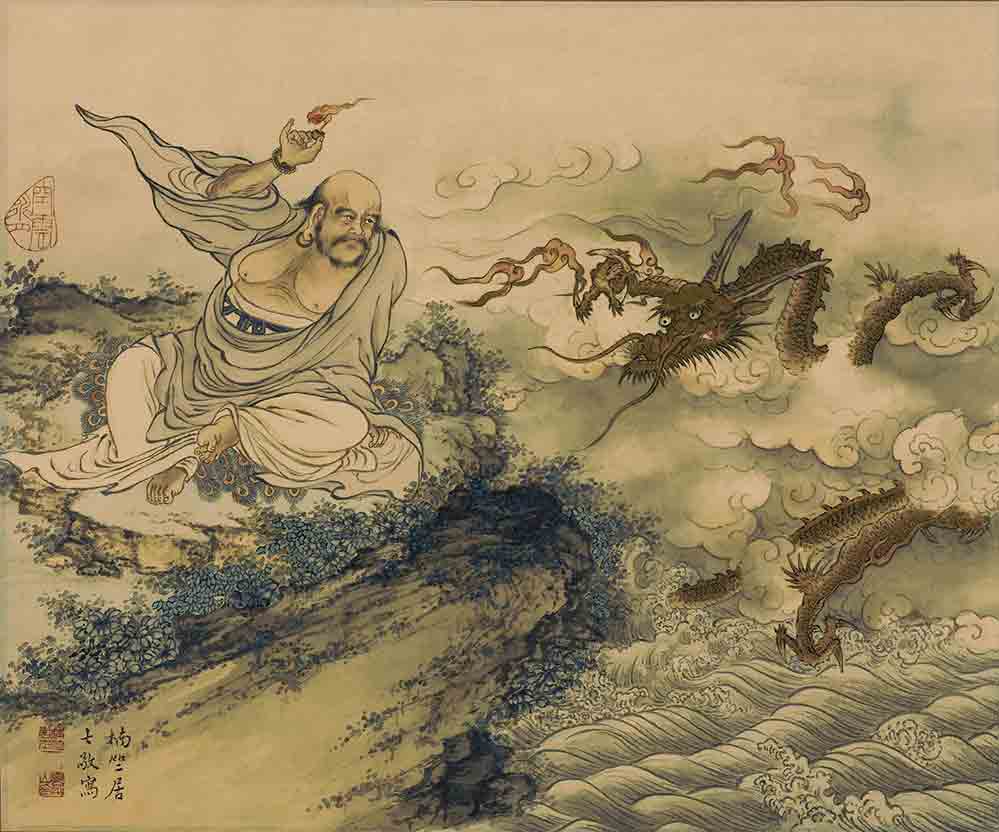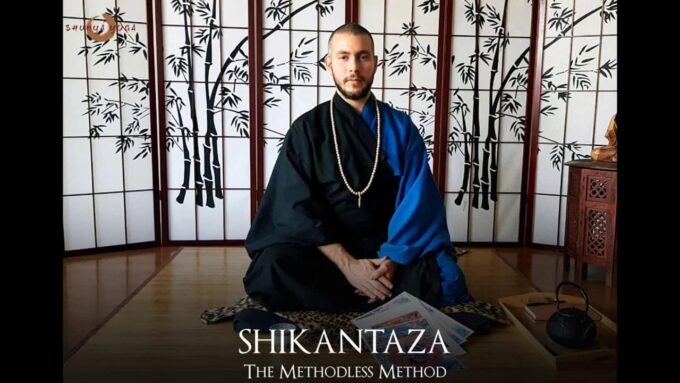THE FIRST ANCESTOR,
One day, the World-honoured One offered up a flower with a twinkle in His eye; Mahakasyapa’s face broke out in a smile. The World-honoured One said, “I have the EYE AND TREASURY OF THE TRUE LAW, the wondrous HEART of nirvana, which I Transmit to Mahakasyapa.”
Mahakasyapa (Mahakassapa) or Kāśyapa was a brahman of Magadha, who became one of the principal disciples of Śākyamuni Buddha and who convened and directed the first council. Mahakasyapa is one of the most revered of the Buddha’s early disciples. He is often depicted in statuary together with Ananda, each standing to one side of the Buddha.
His Indian name was Kāśyapa, which means ‘He of the Tortoise or of the Black-toothed Clan’ whilst in other countries he is known as ‘The Victorious and Esteemed Drinker of Light’. When Mahakasyapa was born, a golden light filled the room, its rays pouring into Mahakasyapa’s mouth, hence the epithet, ‘The Drinker of Light’.
Mahakasyapa belonged to the Brahman caste; as the most respected in society, the Brahmans formed the dominant and highest class in India at the time. Mahakasyapa was born in the country of Magadha. His father was Yingzhe and his mother was Hsiangzhi. At a young age, he looked dignified and handsome, his body radiating a golden hue which manifested from his spiritual vibration that was invisible to ordinary folks. His golden light shone far and wide long before he renounced his layman’s life. At his parents’ request, a highly reliable fortune-teller prophesied, “This child has great, inconceivable merit. He seems destined for monkhood.” Upon hearing these words, his parents feared that they might lose their son to the monastic order.
Mahakasyapa’s parents decided that when he grows up they must find a beautiful girl and have him marry her. When Mahakasyapa reached the age of fifteen or sixteen, they wanted him to get married. He refused many times, but finally gave in to their persistent efforts. Mahakasyapa said to his parents “Well, I respect your opinion, but you must find a girl who is the same color as I am”. “She must radiate light, have a golden body, and look like me. Only then will I marry, otherwise I will remain single!” Once Mahakasyapa’s parents learned that he wanted to find a girl of his own likeness, they had a sculpture of him carved in gold, because not only did golden rays of light shine forth from him, but his physical body was like gold as well. A nationwide search was made for a girl resembling the sculpture. Finally, one such a girl was found, and Mahakasyapa had to honor his promise and marry her.
After Mahakasyapa married the girl, they lived like intimate friends but slept separately, treating each other like fellow practitioners and not having a sexual relationship. A long time after their marriage, they both sought permission from their parents to become monastics, pleading until their wish was granted, whereupon they joined the monastic order and went to different places to pursue spiritual practice.
*
After practicing asceticism in the mountains for some time, Mahakasyapa heard a voice in the sky, “Now a Buddha has descended to the world to teach people. You must go look for Him and follow Him.” Mahakasyapa went to Shakyamuni Buddha’s bamboo grove and, with utmost sincerity, requested that the Buddha accept him as a disciple. Shakyamuni Buddha said, “You are a monk with good merit. Please go shave your hair and beard.”
It is said that no sooner had the World-honoured One addressed him, saying, “Welcome, mendicant monk,” the Mahakasyapa’s hair and beard were forthwith removed and a kesa was draped about his body; he was then entrusted with the Eye and Treasury of the True Law. Mahakasyapa was thus initiated into monkhood and followed the Buddha. He progressed very quickly, easily understanding the profound teachings of the Buddha, and becoming His favorite. He practiced diligently and soon attained arhatship.
On one occasion, Mahakasyapa returned from far away to see Shakyamuni Buddha. Although he had been born into a wealthy family, he practiced asceticism and cared little about his outer appearance. He came in tattered clothes, looking thin, awful and undignified, most probably because of his ascetic practice and lack of sleep and food. He did not deliberately make himself appear so. At the time of his arrival, many other monastics and disciples were gathered around the Buddha, listening to His lecture. They looked at Mahakasyapa with disdain because of his appearance. These disciples were usually by the Buddha’s side, their ample supply of food and clothes ensuring that they looked good and healthy, while the penniless Mahakasyapa practiced asceticism in seclusion in the mountains. Thus, the monks and nuns looked down upon him.
Shakyamuni Buddha noted their reaction and said, Mahakasyapa, come here. I’ll share my seat with you. Mahakasyapa dared not comply and sat on the floor instead. He praised Mahakasyapa for his merits and wisdom, as well as his high spiritual level that put him on a par with fully enlightened saints. These words shocked the monastics, who finally understood and immediately became respectful toward Mahakasyapa. According to Buddhist legend, the Buddha was aware of a karmic connection between himself and Mahakasyapa, and waited for him as his most distinguished disciple to accept him into the order.
One day, during a lecture on Mount Grdhrakuta, Shakyamuni Buddha held up a lotus flower. The audience did not understand the gesture. Only Mahakasyapa smiled.
Photocredit: mygodpictures




